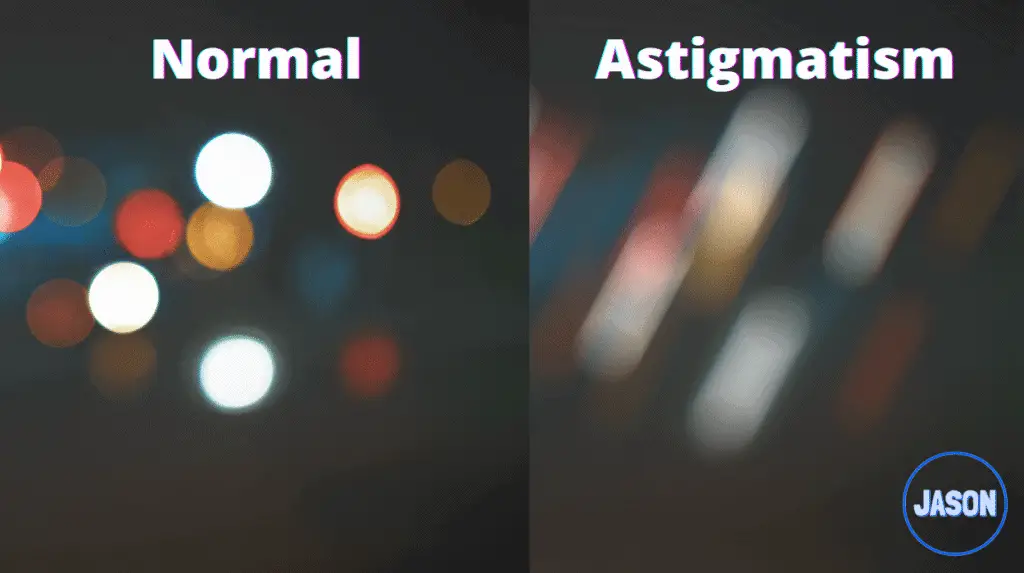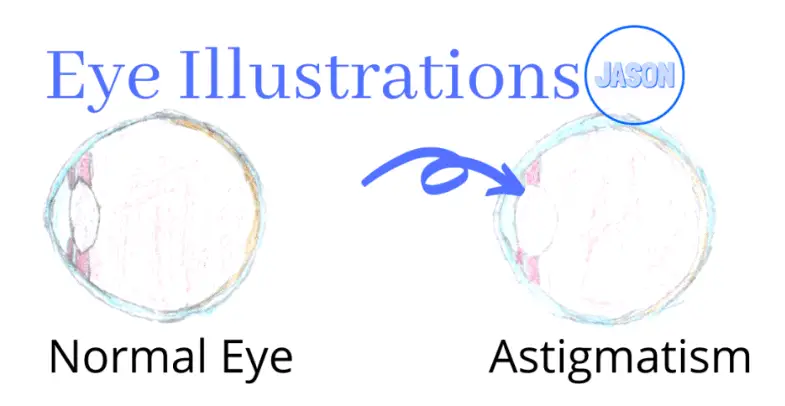Astigmatism 101: Know if you Have It or It’s Getting Worse
Astigmatism is one of the most common refractive errors with 1/3 of US population having the condition. While it is easy to spot if you have astigmatism, some people do not even know they have it.
Your night vision is the fastest and easiest way to know if you have astigmatism, or your astigmatism is getting worse. The lights which look like expanding in a straight line is an easy-to-check method if you have astigmatism.
*See the photo below for reference
While there are more symptoms related to astigmatism, night vision is the easiest since you can do it instantly at night. Other symptoms for astigmatism include: Dizziness, Eye Discomfort, Headache, Eye Squinting, Blurry Vision on some areas and Eye strain.
Source: Vitale, Susan. “Prevalence of Refractive Error in the United States, 1999-2004.” Archives of Ophthalmology, vol. 126, no. 8, 2008, p. 1111., doi:10.1001/archopht.126.8.1111.

How Do I Know If I Have Astigmatism
Check your vision at night. Most if not all people with astigmatism have a poor night vision. Plus, it is easy to spot astigmatism at night since lights you will see will display a straight line pattern. This easy to spot symptom is the easiest, fastest, and free way to know if you have astigmatism.
There are other symptoms for astigmatism. Some are a lot harder to link to astigmatism but these symptoms are also applicable to astigmatism.
These are:
- Eye discomforts such as headache or dizziness
- Eye squinting especially when looking at texts
- Blurry Vision or having blur on some areas only
- Poor Night Vision
- Eye Strain
If you’ve experienced some of these, it is good to check up with a qualified health professional to get a proper check-up, diagnosis, and treatment.
How to Easily Find out if my Astigmatism is Getting Worse
There are two easy ways to find out if your astigmatism is getting worse: one of which is to check if you are having a more difficult time seeing things at night. The other is if you are always experiencing discomforts such as headaches and dizziness.
Since astigmatism is a refractive error in the eyes, people with astigmatism tend to have a really poor night vision. So if you are really having a hard time seeing things at night time, there is a big chance that your astigmatism is getting worse.
Another is if you are getting discomforts such as headaches and dizziness. Astigmatism is closely related to these conditions as eye strain is very common in astigmatism. Too much eye strain can cause these symptoms and astigmatism is one of the culprits.
If you are experiencing some of this, it is best to get a checkup with your doctor. As there are more reasons why you are experiencing these symptoms. There might also be an underlying cause and astigmatism is not always the culprit.
The Varying Degrees of Astigmatism
According to Dr. Ali Moshifar, MD, varying levels of astigmatism can be divided into 4 levels. Less than 0.6 diopters is normal, 0.6-2.0 diopters is considered mild astigmatism. 2.0-4.0 Diopters is considered moderate astigmatism and >4.0 is Severe Astigmatism.
Here is a table summary:
| Astigmatism in Diopters | Level of Astigmatism |
| <0.6 Diopters | Normal |
| 0.6 – 2.0 Diopters | Mild Astigmatism |
| 2.0 – 4.0 Diopters | Moderate Astigmatism |
| >4.0 Diopters | Severe Astigmatism |
Source: Dr. Ali Moshirfar, MD Orthopedic Surgeon at Inova Neurosciences
Most of people who have astigmatism actually doesn’t know they have it. A research conducted on the prevalence of astigmatism concluded that around 1/3 of the people in the US alone have astigmatism.
Most people who know they have one actually are in the mild range already. As the table shows, 0.6 diopters below is considered normal.
However, while it may be the case, a research paper from the World Ophthalmology Congress concluded that people with astigmatism 1.0 Diopters or above have a significant decrease in their quality of life.
Source: Wolffsohn, James S., et al. “Effect of Uncorrected Astigmatism on Vision.” Journal of Cataract and Refractive Surgery, vol. 37, no. 3, 2011, pp. 454–460., doi:10.1016/j.jcrs.2010.09.022.
What Astigmatism Level Requires Glasses
Mild astigmatism usually needs to wear glasses since more than 1.0 Diopters causes a significant decrease in the quality of their life. In actuality, people who have a very mild form of astigmatism can function normally without the need for glasses.
While people who are working in a field where attention to detail is necessary such as video editors, graphic designers, and more, who need to check even little details are required to wear glasses in doing their work.
However, there are instances where you will definitely need glasses. Situations such as when you experience astigmatism symptoms especially discomfort such as dizziness and nausea will definitely need a proper checkup from a health professional.
See table above for your reference on the levels of astigmatism.

You can have more info on astigmatism and glasses in this link where I discussed them in great detail.
Do You Always Need to Wear Glasses for Astigmatism?
If you are in a field where attention to detail is necessary, it is required to use glasses for astigmatism. Not wearing glasses has no scientific correlation with worsening astigmatism. The actual instance when you need to wear astigmatism glasses is if you need them.
Not wearing glasses has no effect in astigmatism. A research paper titled: “Reduction of Astigmatism after Infancy in Children Who Did and Did Not Wear Glasses and Have Strabismus.” found no significant correlation between the two. Thus, if you don’t want to wear glasses, as long as it doesn’t affect your quality of life, then you are free to do so.
In fact, astigmatism usually normalizes at age 25 whether you wear glasses or not.
Source: Ingram, R.M., et al. “Reduction of Astigmatism after Infancy in Children Who Did and Did Not Wear Glasses and Have Strabismus.” Strabismus, vol. 9, no. 3, 2001, pp. 129–135., doi:10.1076/stra.9.3.129.6762.
However, when it comes to your quality of life, if you are experiencing discomforts such as dizziness or your poor night vision is affecting you, it is recommended to wear astigmatism glasses as there is no significant difference between wearing them and not.
What Happens if Astigmatism is Left Untreated
Headaches, dizziness, blurry vision and poor vision at night are the most common experience you will get if you leave astigmatism untreated. There will be times where you can’t see well in the dark and lights look distorted. Also, your vision may be blurry depending on the level of astigmatism you have.
In addition, glasses have no correlation between using them in permanently treating or making astigmatism worse. As stated in a research paper: “Reduction of Astigmatism after Infancy in Children Who Did and Did Not Wear Glasses and Have Strabismus.”
The consistent wear of glasses was not associated with change in both meridia of both eyes in the normal children (p < 0.005), but had no significant effect on the changes in astigmatism.
Source: Ingram, R.M., et al. “Reduction of Astigmatism after Infancy in Children Who Did and Did Not Wear Glasses and Have Strabismus.” Strabismus, vol. 9, no. 3, 2001, pp. 129–135., doi:10.1076/stra.9.3.129.6762.





